

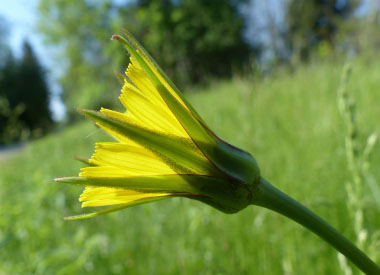
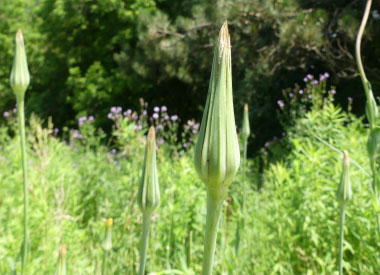
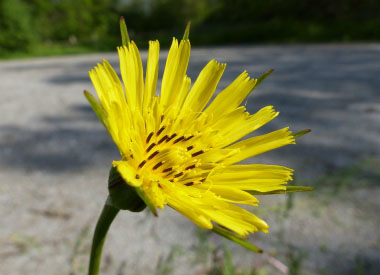
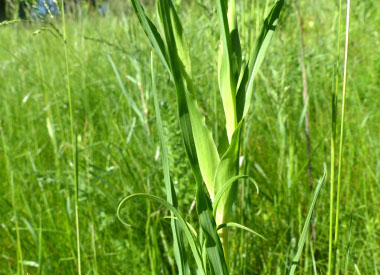

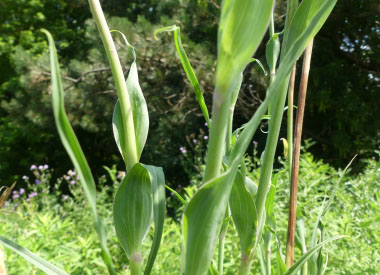
To support our efforts please browse our store (books with health benefits, etc.).
Goat's beard is native to Europe and in the early 1900’s, was possibly introduced into North America as a garden plant. There are some accounts that state it was brought to North America as a food source. It quickly found its way across Canada and the U.S. It is in the Asteraceae Family. 'Tragopogon' is from the Greek 'tragos' meaning goat and "pogon" meaning beard. The genus was named by Linnaeus in 1753. Interestingly, plants may remain vegetative for up to 10 years before flowering. After flowering and going to seed, the plant dies.
Distinguishing Features
This biennial plant produces foliage that has a grass-like appearance. During the first year of growth, yellow salsify forms a rosette of long narrow leaves that look like blades of grass. In the second year, yellow dandelion-like flower heads form at the ends of leafy stems; they measure up to 6cm (1.5”) in width. Goat’s beard flowers usually open and face the sun each morning, twist slightly as they follow the sun until midday, and generally close in the afternoon. Flowers mature into very large, round, white seed heads that are impressive.
Flowers
Flower heads are large, 4 to 6cm (1¾-2¼”) across, are showy, pale lemon-yellow, borne singly at ends of stems and branches. The stalk at the base of the flower head is very thick, hollow, tapering gradually downwards to normal stem thickness. There are usually 10 or more involucral bracts, green, 2.5 to 4cm (1-¾”) long at flowering, elongating to about 7.5cm (3”) or longer as the seeds mature. Only ray florets are present, the outer ones opening first and the unopened inner florets somewhat resembling disk florets. The flower heads open and point towards the sun each morning, twisting slightly and following the sun until midday, then closes during the afternoon. It flowers anywhere from May to July and occasionally continues until September.
 Fields
of Nutrition has medicinal benefits and vitamin/mineral content of Goat's Beard.
Fields
of Nutrition has medicinal benefits and vitamin/mineral content of Goat's Beard.
Leaves
Leaves are alternate with one leaf per node, 30cm (12”) long, narrow, light green, fleshy, and have smooth edges. Leaf bases broaden where they clasp the stem and narrow to a sharp tip. Leaves look similar to grass blades, but unlike grass, they exude a milky juice if broken.
Height
After growing as a rosette in year one, the stems get to heights of 30 to 100cm (12 to 40”) high. They are smooth, round, somewhat fleshy, from a deeply penetrating, thick taproot.
Habitat
Goats beard must have sun to grow. It tends to like disturbed soils, meadows, fields and roadsides.
Edible Parts
The root can be eaten raw or cooked. Young stems, (5 to 10cm), can be eaten as well as at the base of the lower leaves - raw or cooked. These plants tend to be bitter, and unless young or thin, they can be quite fibrous and strong. A long taproot is produced that is thick and fleshy. It tends to be more palatable in its second year of growth.
Other Name
Yellow Salsify.
Similar Plants
Purple Salsify.
Recipes
Winter Survival Food Handbook

PDF Plant Magazines
Types of Wild Food
Geographic Zones Seasons
Disclaimer
EdibleWildFood.com is informational in nature. While we strive to be 100% accurate, it is solely up to the reader to ensure proper plant identification. Some wild plants are poisonous or can have serious adverse health effects.
We are not health professionals, medical doctors, nor are we nutritionists. It is up to the reader to verify nutritional information and health benefits with qualified professionals for all edible plants listed in this web site. Please click here for more information.
Why Edible Wild Food?
- Food costs are rising
- Free, wild food is readily abundant
- Wild food adds nutrition to your diet
- Wild food can help treat various medical conditions





